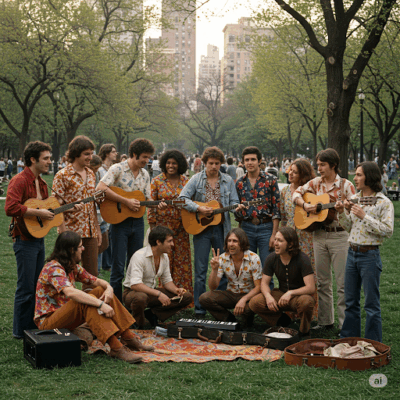From Counterculture to Sixties Culture: Understanding a Transformative Movement
The 1960s marked a pivotal era in American history when young people challenged established norms and created what we now recognize as “Sixties Culture.” This cultural shift wasn’t simply rebellion for rebellion’s sake, but rather a complex social movement responding to multiple factors in American society. The transformation from counterculture to mainstream cultural influence reveals important lessons about social change, generational divides, and the power of collective action.
The Vietnam War: Catalyst for Youth Disillusionment
The Vietnam War served as perhaps the most powerful catalyst for youth activism during this period. Young Americans faced a profound contradiction: they were deemed too young to vote on policies related to the war but old enough to be drafted and die fighting it. This fundamental injustice created deep disillusionment among the younger generation.
Unlike previous American conflicts that were portrayed as heroic endeavors, Vietnam presented a stark reality of confusion, moral ambiguity, and questionable purpose. Media coverage brought the war’s brutality directly into American living rooms, making it impossible to maintain the romanticized notions of warfare that had characterized earlier conflicts.
The anti-war movement organized massive protests that demonstrated the collective power of young people. Songs like “I-Feel-Like-I’m-Fixin’-to-Die Rag” by Country Joe and the Fish captured the bitter irony and frustration felt by many young Americans. These protest songs questioned not only the morality of the war but also exposed the economic interests that supported continuing the conflict.
College Campuses: Incubators of New Ideas
College campuses became crucial centers for cultural transformation during this period. Universities provided:
- Physical spaces where young people could gather and organize
- Access to new and radical ideas through education and discussion
- Protection from immediate economic pressures, allowing time for activism
- Diverse populations that encouraged cultural exchange
The university environment fostered self-expression and critical thinking, encouraging students to question authority and tradition. Free speech movements at universities like Berkeley demonstrated students’ determination to discuss controversial topics openly and without censorship.
Civil Rights: A Model for Social Change
The civil rights movement provided both inspiration and a practical model for the counterculture movement. Young activists witnessed how organized protests, civil disobedience, and collective action could challenge deeply entrenched social systems.
However, many in the counterculture also noticed troubling contradictions in government responses to civil rights activism. While officials might publicly support equality and justice, they often deployed police and military forces against peaceful protesters. This hypocrisy further eroded youth trust in government institutions and mainstream culture.
The tactics and philosophy of nonviolent resistance developed within the civil rights movement influenced other aspects of counterculture protest, from anti-war demonstrations to environmental activism.
Mainstream Rejection: Strengthening Through Opposition
Interestingly, the mainstream rejection of counterculture values and aesthetics actually strengthened the movement in several ways:
- It created a clear identity for countercultural participants
- It fostered solidarity among those who faced similar criticism
- It validated their perception that mainstream society was closed-minded
- It encouraged the development of alternative institutions and communities
Rather than engaging with the substantive critiques raised by young activists, mainstream society often resorted to superficial attacks on appearance, lifestyle, and character. This approach backfired, making the counterculture appear more reasoned and principled by comparison. As the article suggests, in a debate framework, the hippies often emerged as “the mature and collected side,” focused on substantial issues rather than personal attacks.
Legacy and Cultural Transformation
What began as a counterculture eventually transformed American society in profound ways. Many values that were once considered radical became widely accepted:
- Environmental consciousness
- Opposition to unnecessary wars
- Greater emphasis on personal authenticity and self-expression
- Questioning of unchecked authority
- Appreciation for cultural diversity
The movement demonstrated that passionate citizens could indeed create significant social change, even when facing powerful opposition. As the article notes, “all it took was 3 million kids, and a few decades of alienation and the denial of self-expression” to spark a cultural revolution with lasting impact.
Understanding the Historical Context
To fully appreciate the transformation from counterculture to Sixties Culture, we must recognize the historical context. The 1960s followed the conformist 1950s, a period characterized by:
- Cold War anxieties and McCarthyism
- Rigid gender roles and family structures
- Limited racial integration
- Corporate uniformity and consumerism
The counterculture emerged partly as a response to these restrictions, with young people seeking more authentic, equitable, and meaningful ways of living.
Conclusion
The transformation from counterculture to Sixties Culture represents a complex interplay of social forces, not a simple rebellion against parental authority. Young people responded to genuine contradictions in American society—being sent to die in wars they couldn’t vote on, hearing promises of equality while witnessing oppression, and being told to conform to a system that seemed increasingly hollow.
Their response created not just a temporary movement but a lasting cultural shift that continues to influence American society today. The story of the Sixties Culture reminds us that social movements often emerge from legitimate grievances and can, despite significant opposition, ultimately transform the very mainstream that once rejected them.
